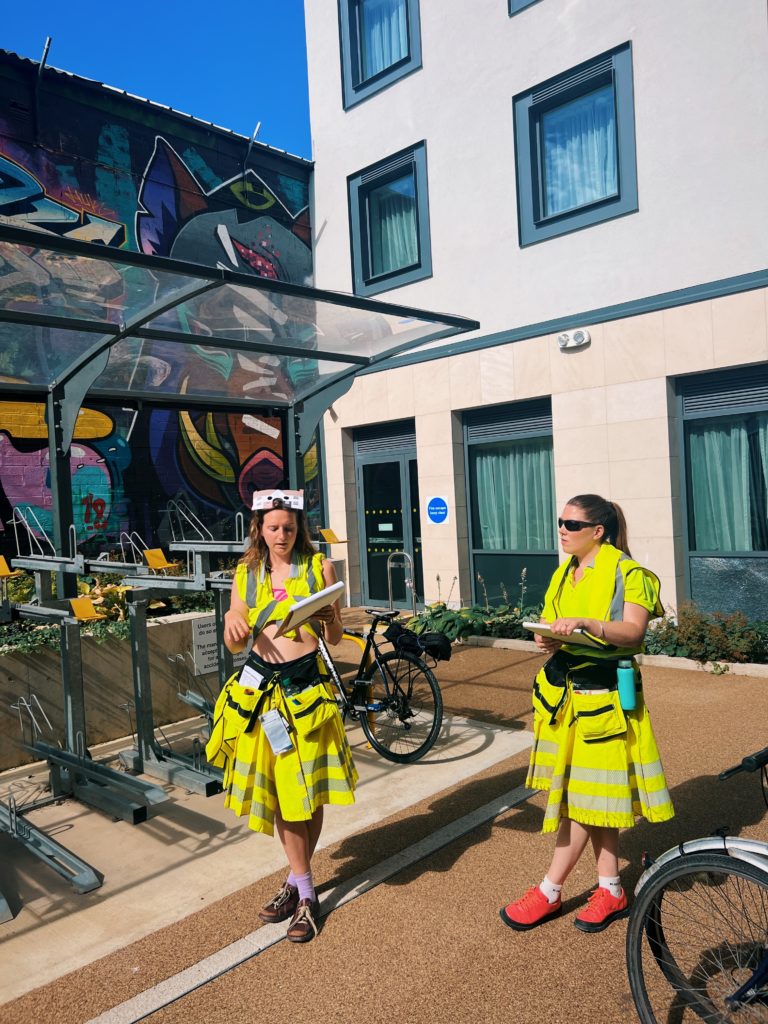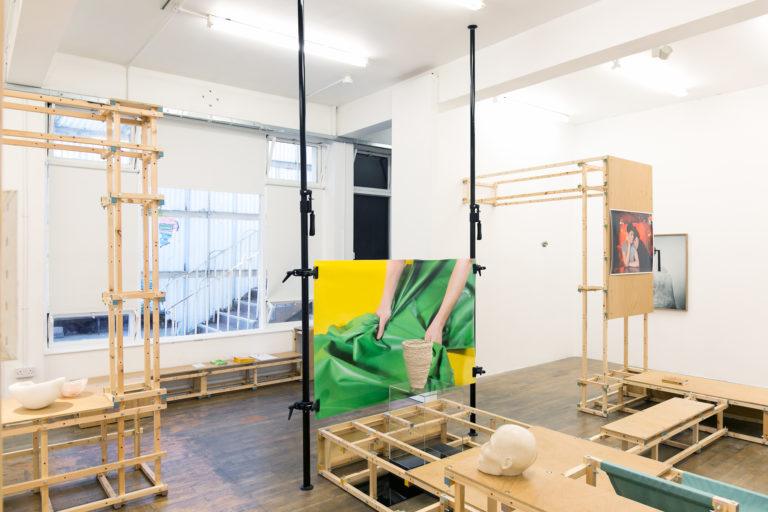Author: Josh Plough
Artists have long been caught in the paradox of gentrification—hailed as avant-garde of urban renewal while often becoming its first casualties. They move into overlooked spaces, transforming them into dynamic hubs of creativity, only for developers to follow, rents to rise, and both artists and long-time residents to be pushed out. But what happens when artist-run initiatives resist this cycle? From the historic wooden houses of Warsaw’s Osiedle Jazdów to Dublin’s ever-precarious artist spaces, communities are fighting back, reclaiming their right to the city and redefining what sustainable cultural spaces can be.

Con: temporary Quarters (Eve Woods and Aoife Ward). Outside the unopened ‘cultural space’ for the Tivoli Staycity Aparthotel, from ‘A Cultural Tour of Hotels in The Liberties’ – © Jack Caffrey
Artists are often seen as the unwitting avant-garde of property developers. The popular and oversimplified scenario goes like this: artists move into a neighbourhood, make it trendy, young professionals move in, and then so do the developers. Rents go up, space is privatised, buildings are demolished, and the original inhabitants, along with the artists, are priced out. It’s a story that’s played out over and over again in cities and towns.
Writing about gentrification for Rural Radicals, author Giulia Gotti explains: “Artist-run spaces often engage in long-term collaborations with people from their neighbourhoods, which can mitigate some of the problems associated with short-term projects and give residents a voice in decision-making processes. Since artist-run spaces can easily fall victim to gentrification themselves, they have a shared interest with their neighbours in resisting it, a ‘solidarity of interest’ that can lead to political organising against real estate speculation. The segregation induced by gentrification forces means that an area becomes inaccessible to large groups of potential residents—who keep the capital running but cannot live there themselves.”[1]
Gavin Murphy, co-artistic director of Pallas Projects/Studios and co-editor of the book and online resource Artist-Run Europe: Practice/Projects/Spaces, says: “The artist-run responds to the needs of the community.” So how can the community respond when it is under pressure? We can look to Warsaw and Dublin for answers.

Periodical Review #7, 2017. Pallas Projects/Studios, The Coombe. Curated by PP/S & RGKSKSRG – © Kasia Kaminska
Warsaw’s Osiedle Jazdów: Safeguarding A Historic and Grassroots Cultural Space
This article is taking shape in a cold, poorly insulated attic in the centre of Warsaw, in Osiedle Jazdów. This area is often described as a ‘green oasis’ in the middle of a city famous for its shades of grey. Osiedle Jazdów (Jazdów Estate) is home to around 20 prefabricated Finnish wooden houses that date back to the immediate aftermath of the Second World War and are closely associated with the almost complete destruction of Warsaw. Originally 90 houses were built here, but over the years they’ve been demolished to make way for developments, notably for the French and German embassies. Jazdów housed the architects and engineers who planned the city’s post-war reconstruction. Now, almost 80 years later, only a handful of houses are actually occupied by residents. Most of them house NGOs, associations, an apiary, and music venues.
In 2013, an organisation, Otwarty Jazdów, was formed to strengthen the community and protect the area’s history and character, ensuring it doesn’t become a place full of cafes and restaurants. The challenge is ongoing as politicians, notably Warsaw’s mayor Rafał Trzaskowski, don’t seem to be interested in preserving the area for cultural and social activities. And last year, a new draft development plan was announced by the district mayor, which proposed that the area should no longer be a residential area, but should allow for the establishment of catering services. This threatens to turn the area into what activists campaigning against the plan call an 'open-air museum.’
In defending Jazdów, activists have said that the estate was/is “a unique experiment on a European scale, which succeeded partly because it was not planned—the largest grassroots, self-organising centre of culture and education in Poland…[and] which constitutes the intangible heritage of Warsaw.”[2]
Threatened by gentrification, the area is in a constant state of flux. It is fighting a battle on two fronts: the cultural and social organisations don’t want to be replaced by Żabkas,[3] and the residents are in danger of being replaced by the social organisations that have moved in. There is no easy way forward when the city is in the midst of a housing crisis, a cost-of-living crisis, and when land, earth, soil are seen only through the lens of a price per square metre.

Ruth Clinton & Niamh Moriarty. Wormhole (drainpipe), 2013. Temporary artwork looking into an excavated site beside Pallas Projects/Studios, now a Hyatt hotel – © Florence Paule G
Dublin ARI’s constant fight
Wherever they are, artist-run initiatives (ARIs) have historically found themselves in spaces that nobody else wants. But now, when everything is for sale and every part of the urban landscape is “desirable” and “up and coming”, space is becoming a rare thing. Those who have it cling to it uncertainly, and those who don’t, have to navigate the profit-driven neoliberal city. Sometimes working with developers, sometimes partnering with larger institutions, but always precariously since these spaces are usually poorly heated and always at risk of something: lease termination, vandalism, rising rents, etc.
To understand more about artist-run spaces and gentrification, Gavin Murphy says more.[4] He explains that Pallas Projects/Studios is celebrating its 30th anniversary, yet its location is still not entirely secure. He described the history of the organisation and how it has moved from one after-use space to another: a dairy facility, to a block of flats, to its current location in the back of an old school. He also made the interesting point that the days of moving into a run-down building, putting up a few partition walls, and turning it into a project space are over. Now there are so many health and safety regulations that buildings have to comply with that you’d quickly spend whatever money you had trying to bring the place up to standard. Fair enough, but it is another hurdle to overcome for ARIs that need to move or are just starting out.
What often binds all these spaces together is their post-industrial/still-industrial quality. In Warsaw, for example, there are ARIs in an old power station, garages, and basements. When discussing gentrification and how it has resulted in closure or pushed ARIs out of the city centre, Gavin mentioned that in 2015 a number of artists, studio operators and artist-run spaces came together as the Creative Spaces Collective to address the problem at a formal, governmental level. The grassroots campaign resulted in a detailed submission to Dublin City Council’s 2016 City Development Plan, requesting that it include provision for artist studios in particular. These objectives were partially adopted in 2016, and further strengthened in the 2022 plan. What came into effect was a target set by Dublin City Council that “all new Special Development Regeneration Areas (SDRAs) and large-scale developments over 10,000 sq. m. in total area must provide a minimum of 5% community, arts, and culture spaces including exhibition, performance, and artist workspaces predominantly internal floorspace as part of their development at the design stage."[5]
As in Jazdów, artists and activists came together, formalised themselves and advocated for a cause. While the victory in Dublin won’t stop the problems associated with developers, it has at least forced the local authorities to act on an issue to which they wouldn’t normally have paid attention.
So where do ARIs go when everything is ‘developed’? When the post-post-industrial cities have nothing to offer but hotels, luxury apartments, and modern student residences? It’s not a rhetorical question, it’s one that needs to be answered as soon as possible. Gavin noted that the certainty that came with a 10-year lease (which ran out in 2022) provided Pallas Projects/Studios with the stability to produce their much-needed Artist-run Europe project. Yet while Dublin artists await concrete outcomes of the city plan, Pallas are often spending 50% of their time lobbying, negotiating and securing space (quite literally as their windows currently need fixing).
If those in the independent cultural sector could direct their attentions and energies to the work at hand instead of worry about bricks and mortar, imagine what could be achieved?
Come together, advocate, and give space to artist-run initiatives.
References
[1] Giulia Gotti, "A review on rural gentrification—what happens when urban development migrates to the countryside?", Rural Radicals, December 29th, 2023
[2] Daniel Tilles, "Activists raise concern over development plans for Warsaw’s postwar 'Finnish cottages'", Notes from Poland, January 8th, 2024
[3] Żabka is a ubiquitous Polish convenience shop that pops up everywhere. You can sometimes find two on the same street.
[5] Chapter 12: Culture, Dublin City Council, 2022
Leila Haghighat, "Hegemonic Struggles in the City: Artist-Run Spaces and Community Art in the Anti-Gentrification Movement", The European Journal of Creative Practices in Cities and Landscapes, Vol 3, no 1, 2020
Published on April 15th, 2025
About the author:
Josh Plough is an educator and researcher who focuses on the world of design and its position in the webs of folklore, identity, politics, and futures. Currently based in Warsaw, he established the cultural foundation and library Fundacja Ziemniaki i, which researches the social relevance of myth and folk practices by placing them in the context of populist politics, belief, and digital technologies. In 2022, he co-initiated FRINGE Warszawa, a three-day event to platform a wide spectrum of independent art and culture initiatives in Warsaw - from artist-run spaces to nomadic and non-commercial initiatives.